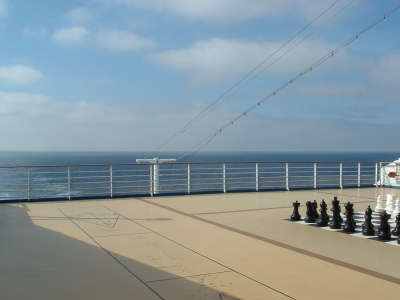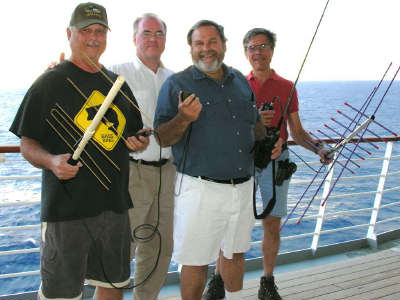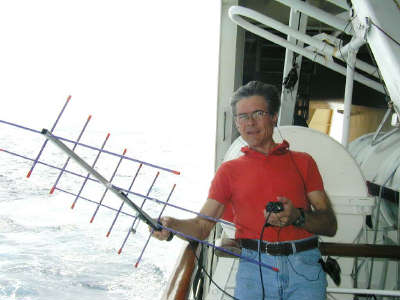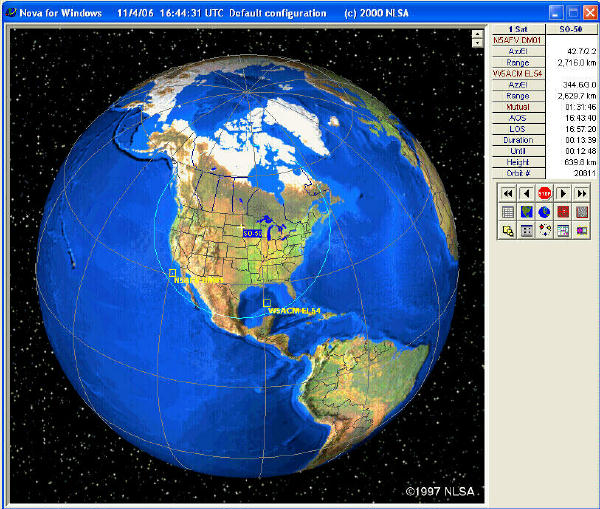Pacific Ocean to
by Andy MacAllister W5ACM and Allen Mattis
N5AFV
The first amateur radio satellite contact between a ship in the Pacific Ocean and a ship in the Gulf of Mexico took place on November 4, 2006. Andy MacAllister, W5ACM, was cruising on a ship in the central Gulf of Mexico in grid square EL54, while Allen Mattis, N5AFV, was located on a ship in the Pacific Ocean approximately 100 miles west of Ensenada, Mexico in grid square DM01. The two operators made contact on SO-50 at 1645 UTC.
Both W5ACM and N5AFV have experience operating from cruise
ships (MacAllister, 1997 and 2000, Mattis, 2003 and 2005a), and they worked
together in advance to plan this contact.
In mid-September Andy and Allen were talking at the weekly Houston AMSAT
lunch and discovered that they would be on cruises at the same time. Andy would be sailing on a western
Caribbean cruise out of
The itineraries for the two cruises were compared, and it was decided that the best opportunity for a contact would be when both ships were at sea because there would be no conflict with tours and sightseeing in the ports of call. In addition, both ships would have to be in the satellite foot print at the same time. Nova for Windows was configured to run two observers and one satellite during the cruise period. It was found that the contact would have to take place in the window of November 2-4, 2006. Because AO-51 was not scheduled to be in V/U mode at that time, only SO-50 was available. Nova for Windows quickly identified the few satellite passes that met the criteria. Two passes of SO-50 were selected as the primary passes when the contact would be attempted.

Photo A: Allen N5AFV found the sports deck of the ship to be
a good operating position.
THE WESTERN FRONT
The equipment used on the cruise ships for the satellite contacts in the FM V/U mode varied. Allen used an Icom W32A HT with a telescoping AL800 antenna. This combination makes an excellent portable satellite station (Mattis, 2005b and 2005c), and contacts have been made on satellite passes with extremely low maximum elevations with this equipment, thanks to the lack of obstructions when operating from ships. Allen has the distinction of being the second station to accomplish the “reverse” VUCC – operation from 100 different grid squares – all via Hamsats.
ON THE EASTERN FRONT
Andy W5ACM had a collection of radios and antennas for his cruise to
the Gulf of Mexico and the western
While Allen N5AFV is known for operations both onboard and on land,
Andy and his group could only operate while at sea due to the lack of licenses
for the ports of call in

Photo B: Eastern Crew – Mike WA5TWT, Craig
WD5BDX, John WA5WOD and Andy W5ACM
Can you make ship-board contacts via AO-51 with SSB up on two meters and FM down on 70 cm? Yes, but it’s not easy. The Yaesu FT-817 with the AL800 long whip provided a good uplink signal. For reception, the Yaesu VR-500 receiver was adequate, but the Alinco DJ-580T was somewhat better. The homebrew, five-element WA5VJB-design Yagi was excellent, and due to the small size and ease of use in the constantly-windy environment of the cruise-ship deck. Four contacts were made on two passes with three stations; W7JPI, N5UXT and KO4MA. Working with all of the different radios and antennas was difficult, but thanks to the efforts of Mike, John and Craig, the passes were tracked, the contacts logged, and no gear or hams were lost over the side.
When AO-51 is not in the preferred V/U FM mode, what does it
take to make successful contacts via SO-50? For N5AFV, the ICOM W32A with the
AL800 antenna and an MFJ-288 headset are quite enough. He’s done it thousands
of times. The W5ACM crew discovered that the older Alinco DJ-580T was having
problems with the signal level from SO-50. AO-51 is much louder (more output
power) and the Alinco needed some help. This was the same HT that had been used
nearly 15 years earlier for successful hand-held operations via AO-21 (also
known as RS-14, RADIO-M1 and RUDAK-2) by W5ACM using the Diamond RH77B
15”-long antenna, earphones and separate microphone (MacAllister, 1992).
After poor results on the first attempt with the Alinco and the AL800, Andy got
the borrowed Arrow antenna up on deck for the next pass. Success! Signals were
strong, easy to hear, and the antenna doesn’t even show any damage from a
few nearby poles and lifeboats that got in the way. There was even a contact
with Bob PJ4/K0NR on the
The eastern W5ACM crew was testing gear during the SO-50
pass that was supposed to be too far to the east for Allen N5AFV out in the
Pacific on November 4th. In the

Photo C: Andy W5ACM/C6A makes contact
with Allen N5AFV/VP9
BACK TO THE WESTERN
FRONT
Allen N5AFV, was in the satellite footprint before the W5ACM group on the 1645 UTC SO-50 pass on November 4, 2006. Allen worked a number of stations during the first part of the pass including K6YK, XE2AT, W6GMT, WI7P, N8BBQ and W0TUP, and just as he was about to leave the footprint, he heard W5ACM calling him and quickly made the contact. Less than a minute later SO-50 was over the horizon - LOS, but the QSO had been successfully completed. W5ACM and N5AFV also made a contact on the following pass of SO-50 at 1828 UTC, but that contact did not generate quite the excitement felt by the operators during that first memorable satellite connection.

Photo D: Nova for Windows display of
SO-50 footprint for 1645 UTC pass on November 4, 2006.
WHY IT WORKED
The effort to make this contact was successful for a number of reasons. Both Andy, his crew and Allen are experienced satellite operators, and have experience operating on satellites from cruise ships. Prior planning, equipment testing and discussion played an essential role. Orbital prediction programs were used to identify the passes that could be used for the contact, and these passes were ranked and prioritized. Also, in finest tradition of amateur radio, the other satellite operators on the pass very courteously stood by while the contact was made.
REFERENCES
MacAllister, Andy, 1992, Satellite Contacts on an HT via OSCAR-21: 73 Amateur
Radio Today, HAMSATS column, October, p. 52.
MacAllister, Andy, 1997, Cruising for AO-27 on the Carnival Sensation: 73 Amateur
Radio Today, HAMSATS column, March, p. 60.
MacAllister, Andy, 2000, Cruising for Satellites: 73 Amateur Radio Today – Special
HAMSATS issue, October, p. 22-28.
Mattis, Allen, 2003, Prior planning - key to a successful DX cruise: The AMSAT Journal,
May/June (Volume 26, No. 3), pp 24-26, (reprinted from Worldradio, 2002, April,
p. 18-21).
Mattis, Allen, 2005a, Satellites and Cruising – A Winning Combination, Proceedings of
the AMSAT-NA 23rd Space Symposium, p 128-138.
Mattis, Allen, 2005b, HT and AL800 Antenna – An Excellent Portable Satellite Station:
The AMSAT Journal, March/April (Volume 28, No. 2), p. 21-23.
Mattis, Allen, 2005c, Postscript to HT and AL800 Antenna – An Excellent Portable Satellite
Station: The AMSAT Journal, May/June (Volume 28, No. 3), p. 17.
Published in The AMSAT Journal, January/February, 2007, (Vol 30, No.1), pp.11-12.
E-mail - [email protected]